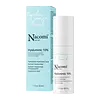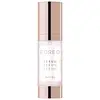What's inside
What's inside
 Key Ingredients
Key Ingredients

 Benefits
Benefits

 Concerns
Concerns

 Ingredients Side-by-side
Ingredients Side-by-side

Water
Skin ConditioningGlycerin
HumectantHydrolyzed Yeast Extract
Skin ConditioningPropanediol
SolventHydrolyzed Glycosaminoglycans
HumectantSodium Hyaluronate
HumectantHyaluronic Acid
HumectantHydrolyzed Hyaluronic Acid
HumectantSodium Hyaluronate Crosspolymer
HumectantCetyl Hydroxyethylcellulose
Emulsion StabilisingLecithin
EmollientXanthan Gum
EmulsifyingCellulose Gum
Emulsion StabilisingCellulose
AbsorbentFructose
HumectantGlucose
HumectantInulin
Skin ConditioningRaspberry Ketone
MaskingSodium Citrate
BufferingPolyglucuronic Acid
Skin ConditioningDehydroacetic Acid
PreservativeBenzyl Glycol
SolventEthylhexylglycerin
Skin ConditioningPotassium Sorbate
PreservativeSodium Benzoate
MaskingBenzyl Alcohol
PerfumingWater, Glycerin, Hydrolyzed Yeast Extract, Propanediol, Hydrolyzed Glycosaminoglycans, Sodium Hyaluronate, Hyaluronic Acid, Hydrolyzed Hyaluronic Acid, Sodium Hyaluronate Crosspolymer, Cetyl Hydroxyethylcellulose, Lecithin, Xanthan Gum, Cellulose Gum, Cellulose, Fructose, Glucose, Inulin, Raspberry Ketone, Sodium Citrate, Polyglucuronic Acid, Dehydroacetic Acid, Benzyl Glycol, Ethylhexylglycerin, Potassium Sorbate, Sodium Benzoate, Benzyl Alcohol
Water
Skin ConditioningGlycerin
HumectantPropanediol
SolventCyclopentasiloxane
EmollientDiglycerin
HumectantXylitol
HumectantPentylene Glycol
Skin ConditioningButylene Glycol
HumectantPEG/PPG-17/6 Copolymer
SolventGlyceryl Polymethacrylate
Glycereth-26
HumectantPEG/PPG-14/7 Dimethyl Ether
Skin ConditioningSqualane
EmollientHyaluronic Acid
HumectantSodium Hyaluronate
HumectantSodium Hyaluronate Crosspolymer
HumectantHydrolyzed Hyaluronic Acid
HumectantBetaine
HumectantOctyldodeceth-16
EmulsifyingGlyceryl Glucoside
HumectantPropylene Glycol
HumectantCaprylyl Glycol
EmollientCarbomer
Emulsion StabilisingTriethanolamine
BufferingAcacia Senegal Gum
MaskingGelatin
Panthenol
Skin ConditioningXanthan Gum
EmulsifyingTrehalose
HumectantUrea
BufferingEthylhexylglycerin
Skin ConditioningAdenosine
Skin Conditioning1,2-Hexanediol
Skin ConditioningSodium PCA
HumectantSerine
MaskingGlucose
HumectantAlgin
MaskingDisodium Phosphate
BufferingGlyceryl Polyacrylate
Pullulan
Hydrolyzed Glycosaminoglycans
HumectantPotassium Phosphate
BufferingCI 14700
Cosmetic ColorantBenzyl Glycol
SolventRaspberry Ketone
MaskingWater, Glycerin, Propanediol, Cyclopentasiloxane, Diglycerin, Xylitol, Pentylene Glycol, Butylene Glycol, PEG/PPG-17/6 Copolymer, Glyceryl Polymethacrylate, Glycereth-26, PEG/PPG-14/7 Dimethyl Ether, Squalane, Hyaluronic Acid, Sodium Hyaluronate, Sodium Hyaluronate Crosspolymer, Hydrolyzed Hyaluronic Acid, Betaine, Octyldodeceth-16, Glyceryl Glucoside, Propylene Glycol, Caprylyl Glycol, Carbomer, Triethanolamine, Acacia Senegal Gum, Gelatin, Panthenol, Xanthan Gum, Trehalose, Urea, Ethylhexylglycerin, Adenosine, 1,2-Hexanediol, Sodium PCA, Serine, Glucose, Algin, Disodium Phosphate, Glyceryl Polyacrylate, Pullulan, Hydrolyzed Glycosaminoglycans, Potassium Phosphate, CI 14700, Benzyl Glycol, Raspberry Ketone
Ingredients Explained
These ingredients are found in both products.
Ingredients higher up in an ingredient list are typically present in a larger amount.
We don't have a description for Benzyl Glycol yet.
Ethylhexylglycerin (we can't pronounce this either) is commonly used as a preservative and skin softener. It is derived from glyceryl.
You might see Ethylhexylglycerin often paired with other preservatives such as phenoxyethanol. Ethylhexylglycerin has been found to increase the effectiveness of these other preservatives.
Glucose is a simple sugar and is the most important source of energy in all organisms.
In skincare, glucose is used to hydrate the skin. It also acts as a prebiotic for our natural biome.
Glucose is hydrating due to its humectant property. As a humectant, glucose draws moisture from the air and from deeper levels in the skin.
Our skin contains many sugars that act as prebiotics and help strengthen our natural microbiome. Having a healthy microbiome helps protect our skin from harmful bacteria and other contaminants.
Studies show glucose may help with fading discoloration and pigmentation. This is because our skin metabolizes glucose into lactic acid. Lactic acid is an AHA that helps exfoliate the top layer of skin.
Learn more about GlucoseGlycerin is already naturally found in your skin. It helps moisturize and protect your skin.
A study from 2016 found glycerin to be more effective as a humectant than AHAs and hyaluronic acid.
As a humectant, it helps the skin stay hydrated by pulling moisture to your skin. The low molecular weight of glycerin allows it to pull moisture into the deeper layers of your skin.
Hydrated skin improves your skin barrier; Your skin barrier helps protect against irritants and bacteria.
Glycerin has also been found to have antimicrobial and antiviral properties. Due to these properties, glycerin is often used in wound and burn treatments.
In cosmetics, glycerin is usually derived from plants such as soybean or palm. However, it can also be sourced from animals, such as tallow or animal fat.
This ingredient is organic, colorless, odorless, and non-toxic.
Glycerin is the name for this ingredient in American English. British English uses Glycerol/Glycerine.
Learn more about GlycerinHyaluronic acid is naturally found in healthy skin. It is a humectant, meaning it draws moisture to your skin.
This ingredient helps hydrate, soothe, and protect the skin.
What makes hyaluronic acid so hydrating? It has the capacity to bind or hold large amounts of water.
Fun fact: It is already naturally found in our bodies, such as the fluids of our eyes and our joints.
Studies find this ingredient to have anti-inflammatory and anti-microbial properties. This can help speed up wound-healing.
Hyaluronic acid can be irritating if the molecule has a low-molecular weight, or if the molecules are small.
One study found low-molecular weight hyaluronic acid to be pro-inflammatory, meaning some people may experience irritation. This is because our bodies use hyaluronic acid in the wound-healing process to signal to our bodies, via irritation, that something needs healing.
The same study found high-molecular weight hyaluronic acid to be anti-inflammatory.
These are some other common types of Hyaluronic Acid:
Learn more about Hyaluronic AcidWe don't have a description for Hydrolyzed Glycosaminoglycans yet.
Hydrolyzed Hyaluronic Acid is a form of hyaluronic acid. It is created by the hydrolysis of hyaluronic acid with a high molecular weight. Once created, Hydrolyzed Hyaluronic Acid has a low molecular weight.
Low molecular weight HA has been shown to hydrate and increase elasticity of the skin. Increasing elasticity is also associated with reduction of wrinkle depth.
One study found topical low molecular weight hyaluronic acid may be considered for the treatment of rosacea in the adult population. However, we always recommend speaking with a professional about your skin concerns.
Hyaluronic acids are a humectant. This means they draw moisture from the air. Hyaluronic acids help moisturize, soothe, and protect the skin.
Read more about other common forms of hyaluronic acid:
Learn more about Hydrolyzed Hyaluronic AcidPropanediol is an all-star ingredient. It softens, hydrates, and smooths the skin.
It’s often used to:
Propanediol is not likely to cause sensitivity and considered safe to use. It is derived from corn or petroleum with a clear color and no scent.
Learn more about PropanediolRaspberry Ketone is a fragrance.
Sodium Hyaluronate is hyaluronic acid's salt form. It is commonly derived from the sodium salt of hyaluronic acid.
Like hyaluronic acid, it is great at holding water and acts as a humectant. This makes it a great skin hydrating ingredient.
Sodium Hyaluronate is naturally occurring in our bodies and is mostly found in eye fluid and joints.
These are some other common types of Hyaluronic Acid:
Learn more about Sodium HyaluronateSodium Hyaluronate Crosspolymer is a type of hyaluronic acid. In fact, it is modified version of hyaluronic acid.
The structure of Sodium Hyaluronate Crosspolymer allows it to stay in the skin's top layer for a longer period of time. This allows for even more hydration and humectant action than hyaluronic acid.
These are some other common types of Hyaluronic Acid:
Learn more about Sodium Hyaluronate CrosspolymerWater. It's the most common cosmetic ingredient of all. You'll usually see it at the top of ingredient lists, meaning that it makes up the largest part of the product.
So why is it so popular? Water most often acts as a solvent - this means that it helps dissolve other ingredients into the formulation.
You'll also recognize water as that liquid we all need to stay alive. If you see this, drink a glass of water. Stay hydrated!
Learn more about WaterXanthan gum is used as a stabilizer and thickener within cosmetic products. It helps give products a sticky, thick feeling - preventing them from being too runny.
On the technical side of things, xanthan gum is a polysaccharide - a combination consisting of multiple sugar molecules bonded together.
Xanthan gum is a pretty common and great ingredient. It is a natural, non-toxic, non-irritating ingredient that is also commonly used in food products.
Learn more about Xanthan Gum